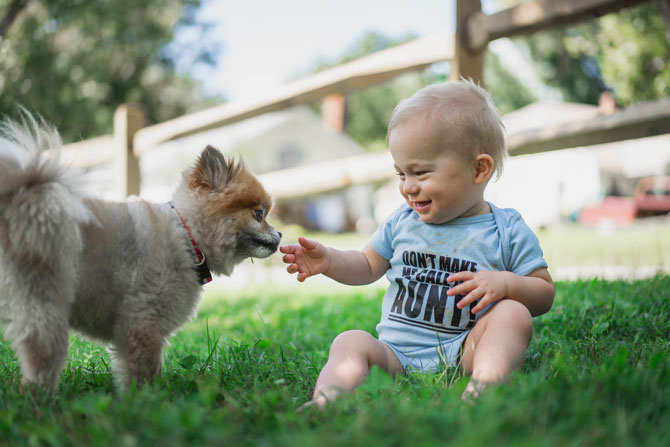Whether you’re pregnant or you’re about to leave the hospital with your little bundle of joy, introducing your pet to your new baby takes some careful consideration. Sure, Kids and pets can be a match made in heaven, providing the initial introduction is positive and a few rules are taught from the off.
The arrival of a baby is an exciting time. However, it tends to bring change, which your family pet might not appreciate. So, in order to make the arrival of ‘Baby’ a wonderful experience for you and your furry friend, it’s essential to plan in advance.
Keep on reading to discover how to implement a new routine that won’t disrupt your dog too much. Plus, learn the simple actions you can take to ensure introducing your pet to your new baby is a relaxed event.
Introducing your pet to your new baby (with relative ease)
While most dogs will welcome your baby into the home with loving paws, some dogs can become unsettled or even jealous. Taking a few necessary precautions will help ensure the safety of your new baby and the emotional wellbeing of your pooch.
Maintain a sense of routine
Dogs like routine. When their usual schedule gets disrupted this can cause them to feel anxious or unsettled. Of course, bring home a new baby is quite likely to alter your pre-baby routine.
So, have a think about what your new routine will look like. Will you need to change the time of day you walk your four-legged friend? Perhaps you might enlist the help of someone else to walk your fur pal! Will feeding times alter?
If there are going to be changes (and you’re able to identify them), it’s best to introduce these before you bring the baby home. This way your barking buddy will not associate change and negative feelings with your little bundle of joy.
Training
If your dog currently sleeps on your bed and this isn’t going to be possible, due to night-time baby feeds, it’s time to train him to sleep elsewhere.
Similarly, if your dog pulls when walking on the lead, how are you going to walk him while also pushing a pram? Training your dog to walk next to you on the lead and obey your commands is essential.
Likewise, if you have a pet that likes to jump into your lap it’s best to train them not to do this. You can still give them comfort and love, but perhaps they sit by your feet to get this affection. After all, the last thing you want is your cat or dog jumping onto your lap when you’re in the middle of breastfeeding your baby!
Finally, it’s likely you will be spending less time with your pooch when the baby comes along. The key is to encourage your fur pal to spent time entertaining himself. You might buy him a few new toys, teach him to spend more time outdoors or introduce environmental enrichment activities. Taking action before you introduce your pet to your new baby will help him adjust and ensure his happiness.
Introduce new stimuli
From the smell of a new baby to the sounds of crying, these new stimuli may negatively affect your pet. To prevent this from happening you can introduce new baby-related sights, sounds and smells before introducing your pet to your new baby. A few ways to do this include:
- Bringing home an item of baby clothing or a blanket from the hospital to allow your pet to become familiar with the baby’s scent
- Allowing your pet to explore your baby’s bedroom (but not jump or sleep on the furniture)
- Begin playing a sound recording of a baby crying
- Allow your pet to see the pram and perhaps take your dog for a walk while pushing the pram
Positive introduction
It’s important to try not to get too worked up about introducing your pet to your new baby. A dog can sense fear and nervousness and this will only make him more anxious.
When first introducing your pet to your new baby make sure your pet is on a lead and there is someone else with you. You can take care of the baby, while the other person can take care of the pooch.
Only allow the introduction if your pet appears calm and happy. If your furry friend looks a little out of sorts or anxious it’s best to leave the introduction for another time.
Theirs is no doubt your pet will want to sniff your baby; it’s the animal’s way of saying hello. Allow this to happen, but keep a close watch and discourage your pet from licking the baby’s face. Also, keep praising your pet for good behaviour and maybe reward him or her with a treat.
It’s best to keep the initial introduction short. Your baby and your pet can spend longer together each time they meet. However, make sure all meetings are supervised. Never leave your baby in a room with your pet unattended.
Without a doubt, pets and children can develop a beautiful and lasting bond. Having a pet brings numerous benefits to the lives of children. A pet can boost a child’s confidence and sense of responsibility, while also reducing their stress and encouraging emotional stability.
Do you have a story to share about introducing your pet to your new baby?
Related posts:
- How to introduce your cat to your new partner
- Pet etiquette for kids
- How kids can benefit from a family pet
Photo by Zachary Kadolph on Unsplash







Leave A Comment